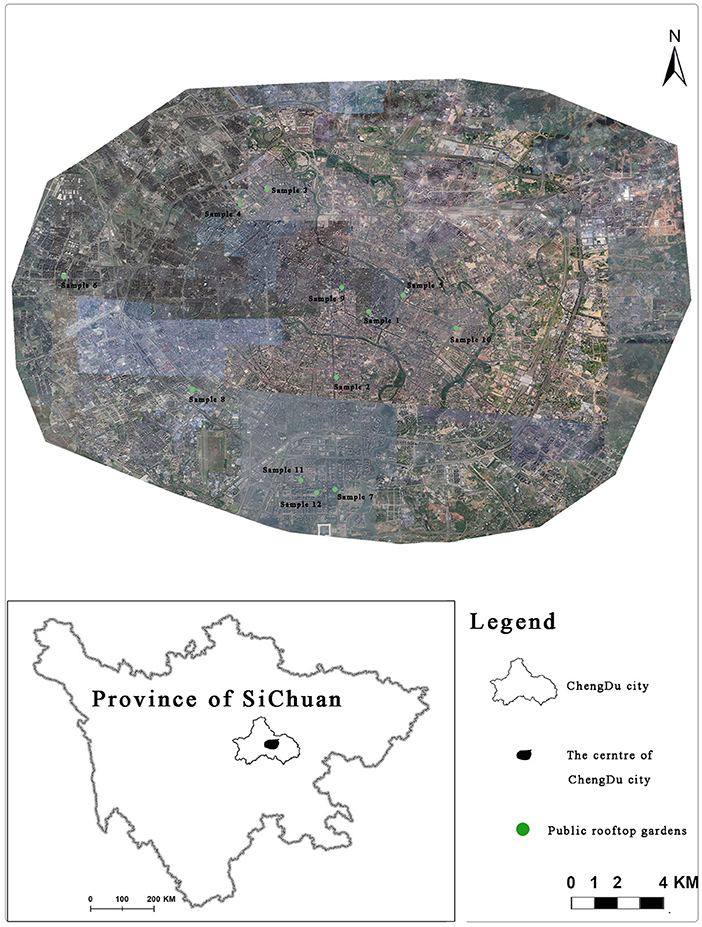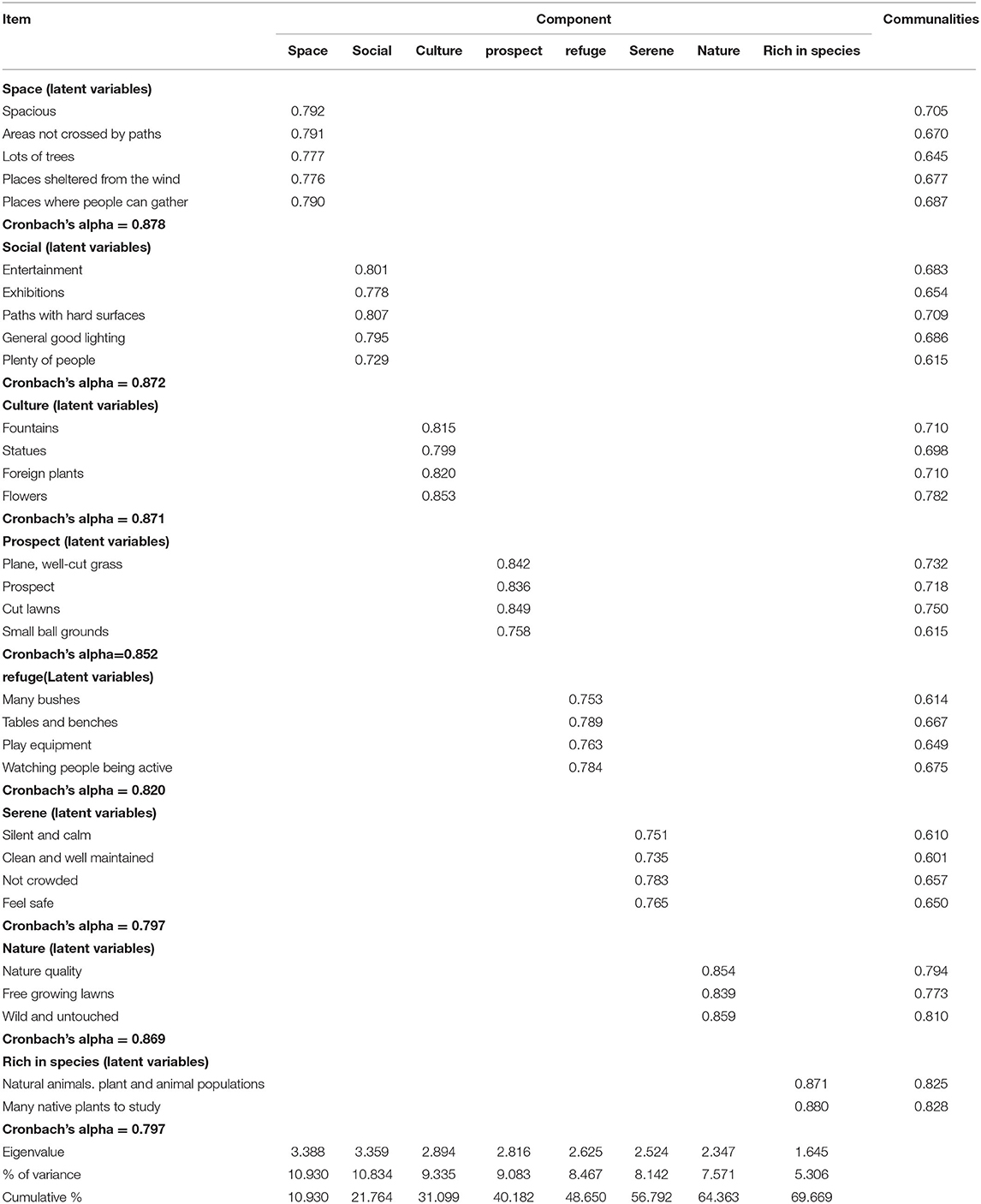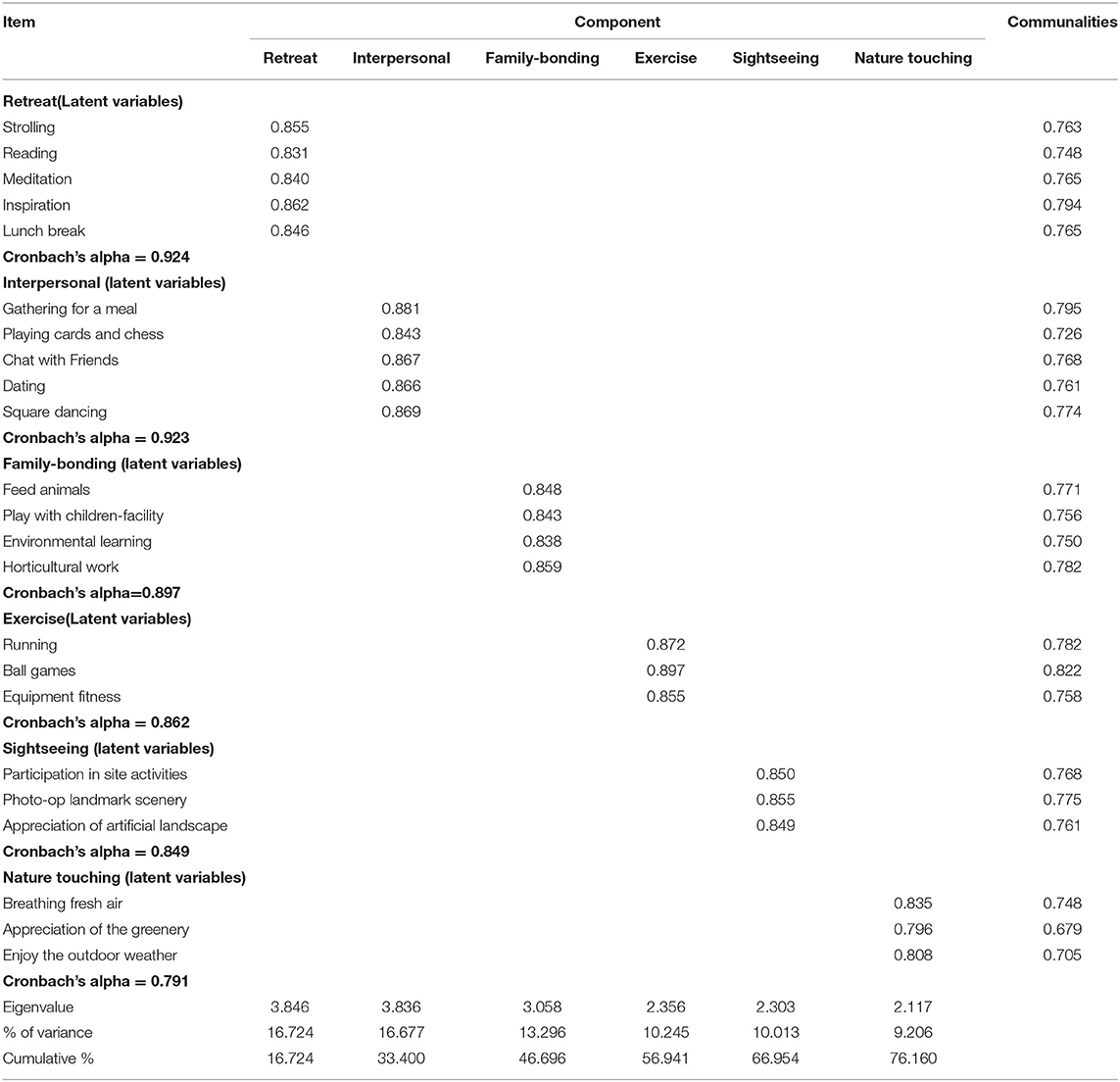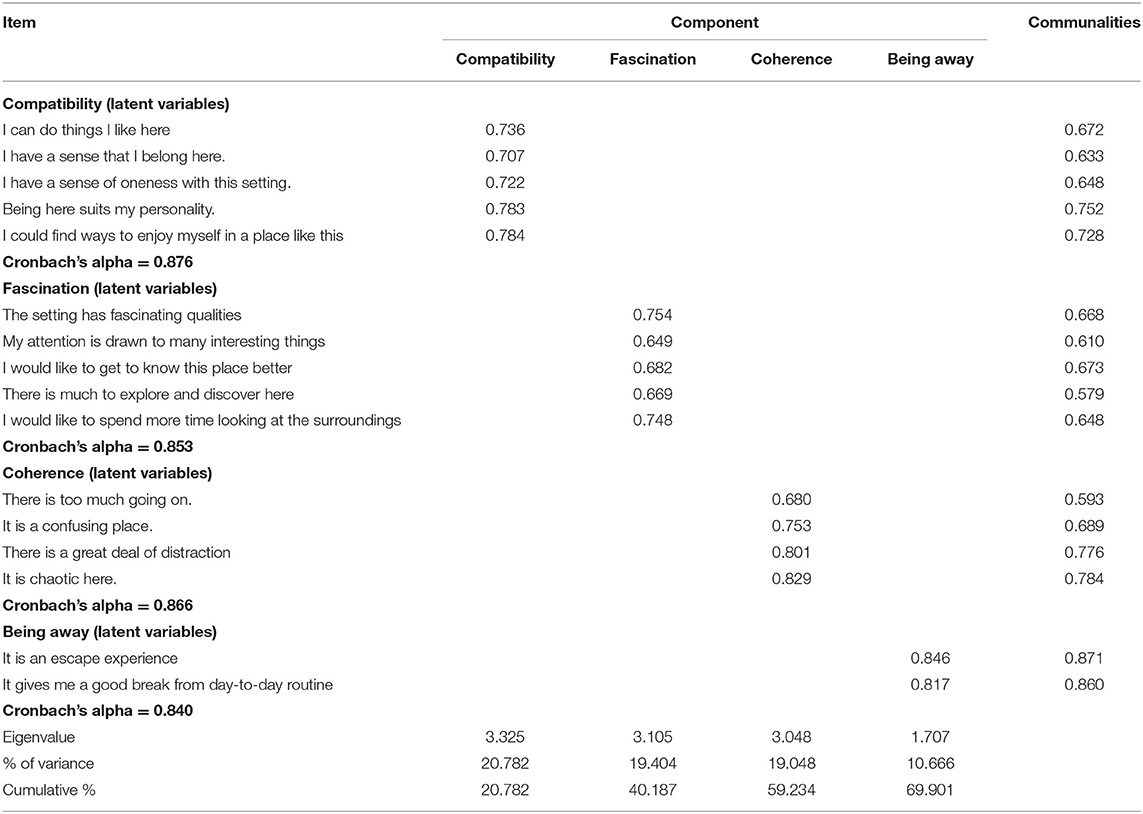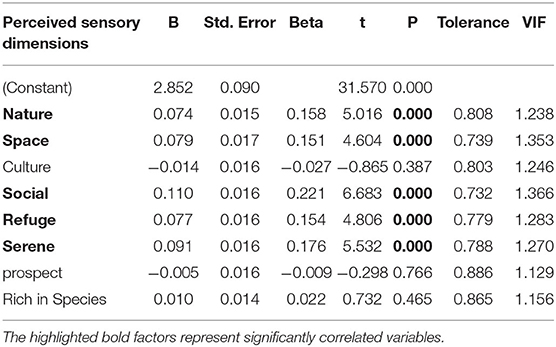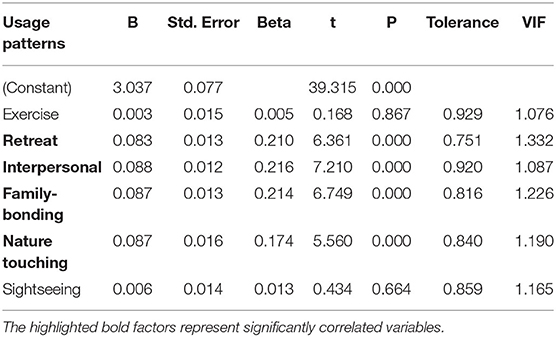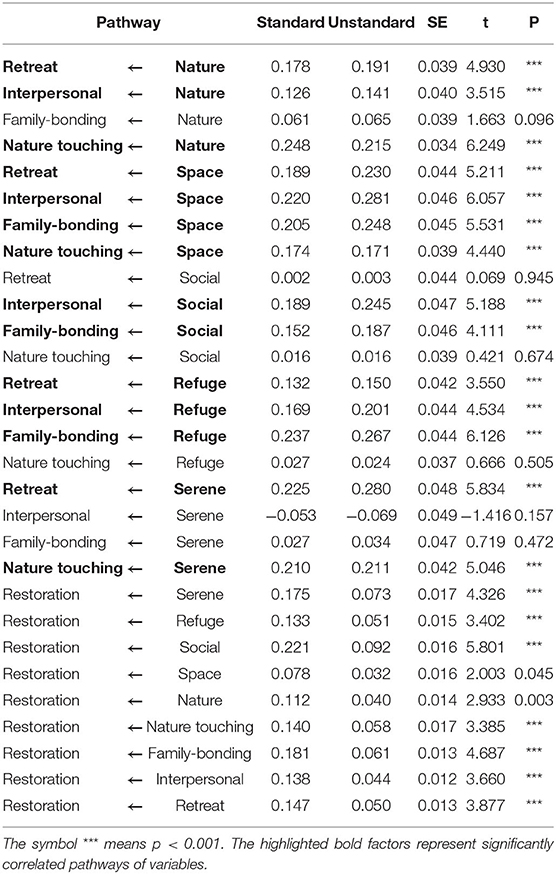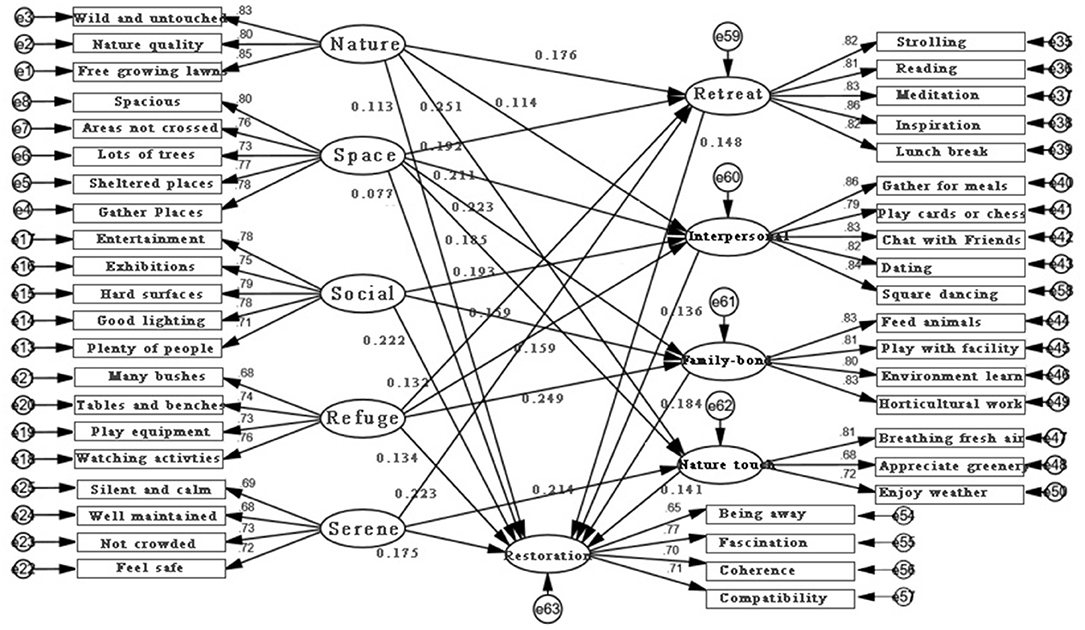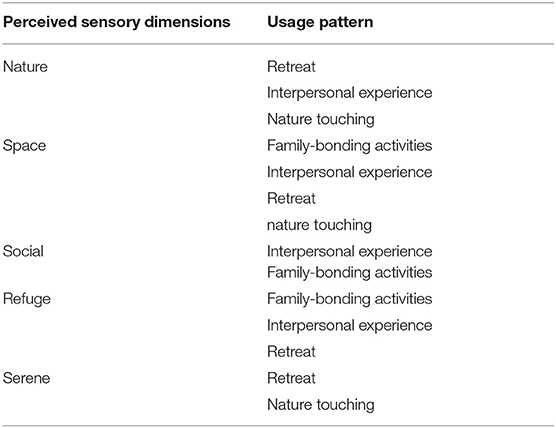- 1School of Architecture and Urban Planning, Chongqing University, Chongqing, China
- 2TCL Studio, Adelaide, SA, Australia
- 3Chinese Society for Urban Studies, Beijing, China
- 4School of Civil Engineering and Architecture, Southwest University of Science and Technology, Mianyang, China
As a kind of informal green space more closely related to the built environment, public rooftop gardens (PRGs) are novel green open space and important salutogenic resource for urban residents. It is one of the most easily accessible method for urban residents to be in contact with outdoor or natural elements from the context of high-altitude living. Given its potential health benefits to city dwellers, existing empirical studies are heavily focused on immediate recovery through visually accessing PRGs (through windows), neglecting the possibility of using PRGs physically as a place of interaction. This paper hypothesizes usage patterns will mediate the associations between the environmental characteristics of PRG and users' restoration. This is done through inputting data from 12 typical samples of PRG in Chengdu, China into structural equation model (SEM). Combining the concept of Perceived Sensory Dimensions (PSD) and Perceived Restorativeness Scales (PRS) with the usage patterns of the above samples, this study aims to examine the correlation of environmental characteristics, usage pattern and restoration, in which identify their relative importance in the context of PRGs. Through serials of numerical tests on the model, the study shows that out of the 20 theoretical pathways constructed by the environmental characteristics (x)–usage patterns (m)–restorative effect (y), only 14 forms a significant correlation. In addition, out of all PSDs, social, serene, refuge, space and nature dimensions are induced into restorative effects through four patterns of use: retreat, nature touch, interpersonal interaction and family-bonding activities. The findings also show that social and family-bonding are the most influential independent and mediating variables respectively in achieving restorative effects in the PRG. This study reveals important findings about how usage patterns mediate the association between the PSD and PRS of users. And it also has generated practical implications on how we can design public rooftop gardens from the perspective of restoration, which could potentially be the key to the future survival and development of PRGs in urban environments.
Introduction
Over the past two decades, the gradual increase in urban density has becoming a common denominator in the world's urban development. Although cities account for only about 3% of land area globally, they are home to more than half of the world's population. According to the World Health Organization (WHO) 2014 prediction, more than 70% of the world's population will live in cities in the next 30 years. Hence, urban areas that are heavily populated will be facing serious environmental degradation, which reduces all the ecosystem services that is part of the natural environment. Consequently, the diminished of these large number of biophysical and cultural services that contribute to health and well-being are going to have considerable impact on the mental and psychological health of the general populations (1–4). As a public salutogenic resource, urban green space has been brought under the spotlight. Scholars assume that it is a typical supportive environment that can achieve both physical and psychological restoration, through emotional improvement, behavioral encouragement, social interaction, and aesthetic experience (5–13).
However, most previous studies were based on a crude comparison of natural and built environments, as well as their respective health benefits. In order to effectively guide the planning and design of urban green spaces to achieve such results, scholars have transformed abstract statistical models into theoretical correlation models of “urban green space characteristics—specific health outcome” (11, 14–20). This aims to provide a basis for empirical research on the design of green spaces from a health perspective. Therefore, numerous tools to evaluate the micro characteristics and restorative effects of the environment have been proposed and implemented (21–25). These have contributed to a more comprehensive picture of the green space and the consequent psychological benefits. The more typical and widely used is the Perceived Sensory Dimensions (PSDs) proposed by Grahn P (26) and the Perceived Restorativeness Scale (PRS) proposed by Hartig T (27). Grahn P summarized PSD as the eight different sensory experiences people get from interacting with the natural environment, including serene, nature, rich in species, space, prospect, refuge, social, and culture. On the other hand, Hartig T described PRS being the capacity of an environment to induce restorative effect through the facilitation of the feeling of fascination, being away, extent, and compatibility. The two ratings have been proven to have a distinctive relationship with different green space types. For instance, under the setting of small urban public green spaces, distinct associations are demonstrated between serene, social, nature and the PRS of people with average and high–stressed. Nature, serene, and refuge are strongly related to those in care settings. Serene, rich in species, refuge, and nature are found to be psychologically restorative in urban forests. Nature, refuge, and prospect are significantly associated with teenagers' perceived restoration in urban green spaces. This also indicates that the degree of association between PSD and PRS depends heavily on the type of green space (14, 15, 28–31) (Table 1).
Yet, it is also identified that human participation is also required for users to achieve restoration among the theoretical models constructed by many scholars. Usage patterns are introduced in studies to further investigate the correlation between urban green space and recovery, such as “moving away from stressors”, “restoring capacity”, and “building capacity” (6, 19, 32–37). Specifically, as an embodiment of restorative effects, the notion of “use” mediates the process of acquiring positive restorative benefits from the environmental, be it from adjusting one's physiological or psychological condition (7, 16–18, 38–42). Furthermore, a large number of reviews also summarizes certain usage patterns where people may derive corresponding benefits from the environment, to some extent, supports the research in seeking positive link between PSD and PRS (19, 36, 43–47). For example, a lawn space can be used for both aesthetic viewing (visual stimulation) and physical activity (physiological promotion) to achieve a reduction in the expenditure of cognitive resources and a decrease in negative emotions. Therefore, as an intermediate process and bridge between the physical environment and psychological feelings, usage patterns are an important mediating variable in exploring the pathway on how PSD connected PRS.
The aforementioned empirical studies tend to focus primarily on green spaces indicated in urban land use and zoning standards, such as parks, urban forests and greenways (38, 39, 48–51). However, high-density urban development has resulted in a significant reduction in the per capita green space, leading to a request for alternative places for nature contact at non-surface level. As informal green spaces that are more closely linked to the built environment, the Public Rooftop Gardens (PRGs) have been neglected in these studies. PRG is a green open space with a certain degree of man-made facilities and natural vegetation that allows urban residents to carry out various types of activities. They are seen as an effective complement and alternative to green open spaces on the ground, especially in densely populated areas, to compensate for the lack of consideration in the provision of open space for the community (52–55). As part of the research on human- place interaction, some researchers have focused on health outcomes through establishing the relationship between the aesthetic value of planting and users' preferences for roof greening (56–61). For example, White and Gatersleben evaluated various forms of roof planting based on self-perceived restoration benefits, aesthetic value, and environmental preference. On that basis, Lee, Loder, Jungles and Nagase used plant form, height, foliage color and biodiversity as the main variables to obtain a significant relationship between users' aesthetic preferences (plant types) and their psychological comfort in rooftop space. Other researchers have experimentally controlled the restorative benefits given to observers with or without green elements in rooftop space (62–64), such as Lee, who demonstrated that green roofs provide observers with attention restoration, relief from mental fatigue and enhanced work performance through “coherence” and “fascination” in micro breaks during days.
While the two research directions confirm the restorative value of PRG from different perspectives, there are two issues where starting point of these studies overlooked. Firstly, the description of PRGs' environmental characteristics is reduced to plant aesthetics, ignoring their complex condition as green spaces. Secondly, the studies based on PRG as a view–a visually accessible window view and neglect its potential to be physically accessible and to take on more activities as open spaces. As mentioned above, the lack of research on these two fundamentals that are important influential factors to the mechanistic model, restricted the further understanding of PRG inducing restorative effect. In China, there are a large number of PRGs that can be used and experienced by all urban residents. These are informal spaces that create and renew gray areas within existing buildings, bringing open space from the public realm into the built environment (65–67). However, due to load, thermal, and usage conditions, the economic demands of stakeholders and the attribute of informal space, there is a lack of uniform standards guiding the planning and construction of PRGs (68–73), suggesting the perceived gap of comprehensive environmental conditions, i.e., PRGs have the potential to provide more public recreational activities that may lead to restorative benefits.
Thus, this manuscript aims to examine how usage patterns (UP) mediate the association of environmental characteristics (PSD) to restoration (PRS), identify the relative importance of different characteristics (PSD), usage patterns and their certain pathways linked to restoration (PRS), as well as to understand impact mechanisms of this new form of greenery using PRGs as the environmental subject. The specific objectives are to address the following questions: Q1: Is there a correlation between PSDs and PRS of PRGs? Q2: Is there a correlation between UPs and PRS of PRGs? Q3:Do UPs mediate the association between PSDs and PRS of PRGs. Q4: The certain pathways transformed from PSDs to PRS.
Methodology and Material
Study Context
Chengdu is located in the transition zone from the western Sichuan Plateau to the Sichuan Basin. It has an average temperature of 15.6~16.9°C, fewer sunny days compared to cloudy days throughout the year, and has an average annual sunshine hour of 1,003 h. The annual average precipitation is 850.9 mm, the annual average rate of evaporation is 841.1 to 1,066.1 mm, and the annual average relative humidity is 81%. All of above stated are especially suitable for the development of roof greening. Apart from climate suitability, high demolition costs and strict law enforcement on higher greening rates within a shortened timeframe foster the need to investigate the role of PRGs within the city of Chengdu. Needless to say the branding of Chengdu as a “park city” in China. These large PRGs become open green spaces for urban residents working and living in the built environment. Hence these are typical areas of study for environmental characteristics and restoration (Figure 1).
Site Definition and Selection Criteria
PRG is also recognized as eco-roof, living roof (74), vegetated roof (69) or cool roof (75). It is defined as green space according to The National Environmental Protection Agency in the broader sense, which implies green space as “land partially or completely covered with herbs, trees, shrubs, or other vegetation” (76, 77). Hence, in this paper PRG is understood as green spaces that provide the opportunities to experience nature and increase physical activity, notwithstanding its role and capability in the regulation of urban heat island effect (78), reducing the overall energy consumption of buildings (79), rainwater detention (79), air purification (72), and increased biodiversity (78). Compared with the other urban green spaces, there was no corresponding data and information on PRGs. This is mainly because they currently do not belong to any land use typology of the city's urban planning guidelines in China. Hence, based on the pre-research and with reference to the application of PSD in traditional urban green space, there needs to be screening criteria for sample selection, in order to ensure that PSD is reasonable for this type of application. Which are shown as follows:
Roofs without enough vegetation are excluded (Green rate less than 20%).
Vacant or storage roofs are excluded.
Roofs that are not open to public are excluded.
Roofs that act like a thoroughfare (such as a podium or elevated bridge structure across two high-rise towers) are excluded.
Outdoor gardens that serve individual businesses (such as coffee shops or restaurants) are excluded.
Monotonic spaces that are unable to provide a variety of activities or host only a single activity (such as football fields and basketball courts) are excluded.
Twenty nine samples were found according to the above criteria. Then, based on information such as the area, shape, vegetation and facilities, 12 out of 29 samples were selected as the typical research samples and numbered them S1~S12. Therefore, it is safe to say the 12 PRGs selected through the screening process are: (1) green open space that meets the needs of urban residents for public access, experience and interaction, (2) green open place to hold various activities, and (3) green open space intended to serve the majority of urban residents and has a relative mix of natural vegetation and man-made facilities (Table 2).

Table 2. The samples of Public rooftop gardens in Chengdu (Source: All photos taken by first author unless otherwise mentioned).
Data Collection
The evaluation of environmental characteristics, usage pattern and restorative effect of PRGs in Chengdu were measured by means of an onsite questionnaire survey. We revised and tested ratings based on the actual condition of sites during the pre-research, then conducted the face to face interviews in the formal questionnaire distribution.
In the Pre-research started on 5 August 2020, every item of the PSDs was rated against actual settings of 12 PRGs on-site by three professional landscape architects. Due to the fact that most items associated with PSDs outlined in previous studies were based off traditional urban green environment, such as small urban green spaces, forests, parks, or care settings, it meant that some of the specific characteristics which described each PSD could not be translated directly into PRGs due to contextual differences. We therefore screen out the items considered not relevant when evaluating PRGs. Meanwhile, real-time status of the users is also being recorded to provide an indication and summary of their usage patterns, i.e., animal feeding, parent-child interaction, meditation and rest, sports and physical exercise, or looking for inspiration.
As a follow up, formal questionnaire distribution started on 31 September 2020, and the frequency of visits to the 12 sites was controlled to an average of six visits per month, which were conducted until the end of the month on 31 June 2021. During this period, 48 visits were conducted by 1–2 members per site sample (at different times of the month, in the morning, around noon, in the evening and on weekends, for 1–2 h each time to reach as many different users as possible). Each survey was distributed at 12 sites at the same time to ensure that external environmental influences such as weather were consistent. Respondents were randomly selected amongst the visitors of the selected PRGs. Questions were asked before distribution to ascertain whether the respondents who agreed to be interviewed were local residents (or lived in the area more than 1 year) to ensure that the content of the questionnaire was a comprehensive reflection of the most realistic current use of the site each time. Those willing to participate were then asked to fill out a questionnaire during their stay in the area, based on their overall perception of the site and their willingness to carry out the corresponding activities within 6 months (Supplementary Table S1).
The questionnaire consisted of five sections. The first part was a survey on motivation, frequency, background, and relevant demographic characteristics (gender, age, education and income level, presence of preschool children, insider or visitor). The second part was an evaluation of the eight perceived dimensions in PRGs. The third part was a questionnaire based on the activities (usage patterns) of the respondents in the specific areas of the site, and the fourth part was a questionnaire on the perceived restorativeness of visiting the site (The fifth part is not relevant in this paper). Correspondingly, a 7-degrees Likert scale was used for the evaluation. Higher scores indicate a greater willingness or agreement of specific item of the questionnaires. The scores of negative questions were being revised for consistency.
During the site investigation, 17,183 users of the sites were recorded, and 1,376 questionnaires (211 paper and 1,165 electronic questionnaires) were distributed. Out of all distributed questionnaires, 899 questionnaires were recovered with a questionnaire recovery rate of 63%. Of these recovered questionnaires 876 were valid, meaning that 97% of the recovered questionnaires were usable. The recovered questionnaires provided an indication to the demographic of all the PRGs users: External visitors (73.3%), females (53%), people with preschool children in family (54.8%), young and middle-aged people (18–39 of age, 58.5%), people with an average lower income (<4,999, 59.2%), and people with a lower education (under vocational education, 70.2%) constitute the main use groups of the site. However, it is utmost important to note that no significant differences were found between the responses of people with different background subjects.
Data Screening and Analysis
Structural Equation Model (SEM) was chosen to construct the final theoretical model in this paper because it (1) introduces latent variables that can be included in the evaluation of multiple specific items in a complex, multi-linked statistic, facilitating the presentation of the causal structure of the variables from a holistic perspective;(2) SEM is similar to multiple regression and path analysis in that they are solved using a system of coupled equations, but unlike the two, it allows for measurement error between variables; (3) SEM can eliminate confounding factors while taking into account the relationship between multiple variables.
The modeling steps were shown in turn: comprehensive data validation tools were used upfront, followed by series of linear regression analysis to screen out uncorrelated variables in order to simplify the construction of structural equation model. Finally, the relevant variables were input into AMOS to establish SEM, and the path coefficients were used to determine whether the theoretical conjecture was valid and the respective contribution.
Specifically, original data was first statistically analyzed to ensure whether it was available for subsequent statistical analysis. Mean and standard deviation were used to describe the data for continuous variables, while frequency and percentage were used to define categorical variables. Then, Harman's one-way ANOVA was used as the test for common method bias to eliminate artificial covariation of the evaluation ratings that can seriously confound results and potentially mislead conclusions.
After that, exploratory factor analysis (EFA), confirmatory factor analysis (CFA) and Cronbach's alpha were used in this study to verify if the data supported the grouping of dimensions of different ratings. Furthermore, corresponding mathematical structures were tested using CR (composite reliability) and AVE (average variance extracted), respectively.
Then a series of multiple linear regression analysis was then used to determine the possible association among the independent variables (PSD ratings), mediating variables (UP ratings) and dependent variables (PRS ratings). Specifically, the models estimate which independent and mediating variables have significant effects on dependent variables, and this is to simplify post-modeling by filtering out irrelevant variables.
All of the above are prerequisite test for the development of a valid mathematical model. Finally, an optimized structural equation model of latent variables was developed to verify the mediating role of each mediating variable between the independent variable and the dependent variable through AMOS. The test level (Significant level) was 0.05, i.e., P < 0.05 indicated that the difference was statistically significant. The model reveals what degree of environmental characteristics are associated with users' restorative effects and the mediating role of usage patterns through path coefficients. It also illustrates the different pathways between certain environmental characteristics and restorative effects.
Results
Results from these analyses are described and presented in the following sections: Confirmatory analysis and Main analysis. These sections follow the steps of Data screening and analysis corresponding to the research questions highlighted in the previous chapter. Confirmatory analysis aims to verify whether the data supported the grouping of dimensions of different ratings for the subsequent analysis, followed by Main analysis to respond the research question.
Confirmatory Analysis
Prior to answering the research questions, it was firstly verified whether the variables supported the grouping of dimensions described as PSD as well as PRS, while the dimensionality of the data related to UP was examined (Tables 3–5).
Specifically, the results showed that the cumulative variance contribution of the PSD rating was 69.669% > 60%, i.e., when eight common factors (refuge, social, serene, space, nature, rich in species and culture) were extracted. While the cumulative variance contribution of the UP rating was 76.160% > 60%, i.e., When six common factors (retreat, exercise, interpersonal, family-bonding, nature touching, sightseeing) were extracted. Finally, the cumulative variance contribution of the PRS rating was 69.901% > 60%, i.e., When four common factors (fascination, compatibility, coherence and being away) were extracted. That is, the three can better cover the subject of the study through a principal component analysis strategy.
Main Analysis
Q1: The Correlation Between PSDs and PRS?
The effect of the PSD rating (as the X-value of the equation) on the PRS rating (Y-value) was explored by multiple linear regression analysis, incorporating variables such as nature, space, culture, social, refuge, serene, prospect, rich in species and perceived restorativeness as the dependent variable. The regression results show that culture, prospect and rich in species did not have significant effects on the restoration (P > 0.05). Nature, space, social, refuge and serene have significant effects on the restoration (P < 0.001), and the β values were 0.158, 0151, 0.221, 0.154, 0.186, and 0.022, respectively, so it was concluded that these dimensions had significant positive effects on Y (Table 6).
Q2: The Correlation Between UPs and PRS?
The effect of the UP rating (as the M-value of the equation) on the PRS rating (Y-value) was explored by multiple linear regression analysis, incorporating variables such as exercise, retreat, interpersonal, family-bonding, nature touching, sightseeing and perceived restorativeness as the dependent variable. The regression results show that exercise and sightseeing did not have significant effects on the restoration (P > 0.05). Retreat, interpersonal, family-bonding, nature touching have significant effects on the restoration (P < 0.001), and the β values were 0.210, 0.216, 0.214 and 0.174, respectively, so it was concluded that these dimensions had significant positive effects on Y (Table 7).
Q3: The Mediating Effect of UPs
Based on the results of the aforementioned regression analysis, a preliminary structural equation model of UP ratings between the PSD and the PRS ratings was also constructed after removing the irrelevant variables, incorporating nature, space, social, refuge and serene as independent variables. Incorporating retreat, interpersonal experience, family-bonding activities and nature touching as mediating variables. Incorporating restoration as the dependent variable. The model plots and analysis results are presented below.
The results of the structural equation model analysis are presented in the table. The analysis results show that: the effect of nature on family-bonding activities is not significant (P = 0.096 > 0.05), social has a non-significant effect on retreat (P = 0.945 > 0.05), it also has a non-significant effect on nature touching (P = 0.674 > 0.05), and refuge had a non-significant effect on nature touching (P = 0.505 > 0.05), serene had a non-significant effect on interpersonal experience (P = 0.157 > 0.05), serene had a non-significant effect on Interpersonal experience (P = 470.05 > 0.05). This means that 14 of the 20 pathways are significantly correlated, which prove the mediating role of usage pattern between PSD and PRS (Table 8).
Q4: The Pathway of PSDs Linked to PRS of PRG
After optimization of the structural equation model by eliminating several insignificant paths between X—M—Y variables, fit indices of the optimized model all met the fit criteria, and it was considered to be a good model structure that was supported by the data. The results of the optimization of the non-significant paths in the structural equation model, as previously mentioned, are presented below (Figure 2).
The results of the optimized structural equation model show that for the effect of environmental characteristics on restorative effects, nature, space, social, refuge and serene all show a significant positive effect on restoration (p < 0.05), with standardized path coefficients of 0.113, 0.077, 0.222, 0.134 and 0.175, respectively. The effect of the mediating variable M on the dependent variable Y was as follows: retreat, interpersonal experience, family-bonding activities and nature touching all have a significant positive effect on restoration (all p < 0.001), with standardized path coefficients of 0.148, 0.136, 0.184, and 0.141, respectively.
To verify the different pathways between environmental characteristics and restorative effects, each path coefficients of independent variable X on mediating variable M will be covered in detail (Table 7). For example, the dimension of nature achieved restoration through retreat, interpersonal experience and nature touching (all p < 0.01), with standardized path coefficients of 0.176, 0.114 and 0.251, respectively. The dimension of space achieved restoration through family-bonding activities, interpersonal experience, retreat, and nature touching (all p < 0.001), with standardized path coefficients of 0.192, 0.211, 0.223, 0.185, respectively. The social dimension achieved restoration through interpersonal experience and family-bonding activities (p < 0.001), with standardized path coefficients of 0.193 and 0.159, respectively. The dimension of refuge achieved restoration through family-bonding activities, interpersonal experience and retreat. (p < 0.001), with standardized path coefficients of 0.132, 0.159 and 0.249, respectively. The dimension of serene achieved restoration through retreat and nature touching (p < 0.001). The standardized path coefficients were 0.223 and 0.214, respectively.
Discussion
The Relationship Between PSD, UP and PRS on PRG
One of the main research questions was to examine how through different use, certain environmental characteristic could provide restorative benefits. Our results confirmed the hypothesis that out of the 20 theoretical pathways constructed by the PSD (x)—UP (m)—PRS (y), only 14 formed a significant correlation. This suggests that environmental characteristics facilitate some specific usage patterns in a way that allows the user to achieve recovery (Table 9).
In response to the first research question, it was found that there is a positive relationship between PSDs and PRS. Social and serene are repeatedly the most important PSDs connected to PRS. This result correlates with the conclusion outlined in the research on small public urban green spaces (SPUGS) (14). This is considerably different when we look at PSD and the respective PRS in different settings. For example, refuge, rich in species are the important PSDs associated with urban forest (29); nature and serene within care settings (31); as well as refuge and prospect under park setting (28). The findings of this paper may be attributed to the following reasons: in comparison to the European, Chinese residents tend to socialize in an outdoor environment for stress relief rather than in the hustle and bustle of urban life (30, 80). PRGs can hence potentially compensate for basic needs of socializing in natural environments on busy workdays within urban areas. Similarly, compared with SPUGS, PRGs are elevated that they are far away from the source of vehicular noise on the ground, which could be seen as a scarce green space for people to obtain tranquility or peace in the built environment (62). Therefore, PRGs are easily perceived as places for temporary escape from the pressure of life and work. It is worth mentioning that the above two dimensions seem to contradict when placed within an environment. However, it may be due to the relatively large scale of PRGs, PRGs design strategies that improve delineation as well as management through a well- established operation and maintenance regime, which ensure the integration and coexistence of these two (59, 65, 70, 73).
Regarding to second research question, there is a correlation between UPs and PRS according to the result. Retreat and family-bonding activities are repeatedly most important mediating variables linked PSDs and PRS of PRG. It coincides with some scholars underpinnings on restorative experience of PRG (52, 54, 55, 62, 81). For instances, to take the children out, to find peace and quietness. Unexpectedly, out of all UPs, nature touching had relatively low impact on the restorative effect. As a contrary to green spaces on ground whereby the most restorative experience would normally be nature contact (32, 82–89), this study confirms that the current restorative function of PRG was possibly closer to being a participatory farm or place for short-term break, than being a natural space, from the perspective of users.
On the final research question, social, refuge, serene, space and nature were inducted into restorative effects through four patterns of use: retreat, nature touch, interpersonal interaction and family-bonding activities. Our findings validate the importance of mediating mechanisms in restorative environments, which supported previous study conclusions (32–35). Specifically, this study revealed that environmental characteristics of nature such as “wild and untouched” and “growing lawns” contribute more to the creation of a space where visitors feel the inherent power of the environment without human intervention, and their association with restorative effects can be induced by encouraging meditation or the appreciation of greenery. Environmental characteristics of space, such as “spacious” and “places where people can gather”, contribute significantly to creating a spatial atmosphere where visitors can feel a sense of diversity and variation in the environment, and these will induce restorative effects by encouraging meditation, gathering, playing with children or enjoying outdoors. The environmental characteristics of social such as “paths with hard surfaces”, “entertainment” and “good general lighting” contribute more to the creation of a place where people can meet and interact with others, and these can induce restorative effects through the facilitation of gatherings, reunions, playing with children. Environmental characteristics of refuge such as “many bushes” and “watching people actively”, which contribute to the creation of environments offering a sense of shelter and protection, these can be used to induce restorative effects by promoting relaxation, dating and gardening. Environmental factors of serene such as “feeling safe” and “not crowded” contribute more to a peaceful atmosphere without disturbance and can result in a positive restorative effect by promoting the use of relaxation, inspiration and the appreciation of greenery.
These findings suggest changes in environmental characteristics can trigger the willingness of people to carry out certain activities and thus obtain a restorative effect. Hence, it broadens the boundaries of restorative environmental design considerations. For example, even though the social dimension generated the largest contribution to the restorative effect, the space dimension had the most comprehensive correlation pathways in the process of achieving restorative effect. This means that while the user reaps the greatest amount of benefit from the social dimension, the space dimension offers a greater variety of ways to benefit.
Implications for Landscape Designers and Planners
The current lack of uniform standards guiding the planning and construction industry restricted future survival and development of PRGs in urban environments. The PSDs can comprehensively summarize each environmental characteristic in detail, and thus, they can be used both as a tool for analysis and as design guidelines for designers and planners.
This study has generated practical implications on how we can design public rooftop gardens targeted specifically around potential usage patterns and health benefits. For example, the PRGs should be designed with space or facilities for entertainment and exhibitions, paths with hard surfaces and general good lighting also need to be provided. These characteristics can induce restorative effects through the facilitation of gatherings, reunions, playing with children.
This study also suggested that providing a well maintained and not crowded space is necessary for human-place interaction. Serene atmosphere that makes people feel silent and calm, or feel safe is also important. These characteristics would be associated with restoration through promoting the use of relaxation, inspiration and the appreciation of greenery.
Nevertheless, the findings of this paper should be considered as a valid complement to the previous roofing studies that focused only on the aesthetic characteristics of plants, or as a design guideline for the PRG construction process, rather than a limitation in an absolute sense.
Strengths and Limitations
This study has generated knowledge on the actual status of PRGs through collecting and describing the individual perception or behavior, and it is also the first attempt to concretize the characteristics of PRGs by combining the PSD as well the PRS in the context of China. In addition, this paper verified the pathway between the two mentioned above.
However, there are some limitations in this paper that need to be tackled in future research. First, the study samples applied in this paper are all over 2,000 m2. The ignorance of smaller-scale potential samples may affect the overall representativeness of PRGs. Then, the respondents were limited to adults aged 18 and above, ignoring the users of younger age, especially teenagers.
Conclusion
This study revealed important findings about how usage patterns mediate the association between the PSD and PRS of users. It concluded that the five perceived sensory dimensions of social, refuge, serene, space and nature were induced into restorative effects through four patterns of use: retreat, nature touch, interpersonal interaction and family-bonding activities. It also found that family-bonding activities were the most influential mediator in achieving positive restorative effects in the PRG, with the remaining activities ranked as follows: retreat > nature touching > interpersonal interaction. A comparison of the path coefficients of the dimensions revealed that “fascination” brings about slightly more restoration than the rest, suggesting that more attention should be given to the setting of scenes related to it. The study also confirmed that five out of the eight environmental characteristics of PRGs had restorative effects, with the degree of influence being social > serene > refuge > nature > space. The findings increased knowledge on the pathways linked to PSDs and PRS amongst users of PRGs. However, in view of the diverse functions of these sites (PRGs), future researchers should investigate whether the PSDs/PRS pathways established will significantly differ under different PRGs. Given this study also shows that access to restorative benefits depends not solely on the characteristics of the environment but also on the specific ways in which they use it, this will also lead to the question if typologies of PRGs will induce specific usage patterns, that in turn strengthening furthers the pathway. In addition to this, individual needs or external conditions will also have a distinctive effect on usage patterns, such as age, gender, income level (7, 90–93)or thermal condition (94–99). Hence, additional moderating variables could be potentially introduced into this model to further improve the theoretical framework and conceptual model of the correlation pathway in PRGs in future research.
Data Availability Statement
The original contributions presented in the study are included in the article/supplementary material, further inquiries can be directed to the corresponding author/s.
Ethics Statement
Ethical review and approval was not required for the study on human participants in accordance with the local legislation and institutional requirements. Written informed consent for participation was not required for this study in accordance with the national legislation and the institutional requirements.
Author Contributions
ZC and TZ: conceptualization. ZC and QD: methodology. ZC: investigation, visualization, and writing—original draft preparation. KKG and TZ: review. TZ and MZ: supervision. All authors have read and agreed to the published version of the manuscript.
Conflict of Interest
The authors declare that the research was conducted in the absence of any commercial or financial relationships that could be construed as a potential conflict of interest.
Publisher's Note
All claims expressed in this article are solely those of the authors and do not necessarily represent those of their affiliated organizations, or those of the publisher, the editors and the reviewers. Any product that may be evaluated in this article, or claim that may be made by its manufacturer, is not guaranteed or endorsed by the publisher.
Supplementary Material
The Supplementary Material for this article can be found online at: https://www.frontiersin.org/articles/10.3389/fpubh.2022.801453/full#supplementary-material
References
1. Barton H. Land use planning and health and well-being. Land Use Policy. (2009) 26:115–23. doi: 10.1016/j.landusepol.2009.09.008
2. Barton H, Thompson S, Burgess S, Grant M. The Routledge Handbook of Planning for Health and Well-Being: Shaping A Sustainable and Healthy Future. London: Routledge (2015). doi: 10.4324/9781315728261
3. Velarde MD, Fry G, Tveit M. Health effects of viewing landscapes - Landscape types in environmental psychology. Urban For Urban Green. (2007) 6:199–212. doi: 10.1016/j.ufug.2007.07.001
4. Shooshtarian S, Rajagopalan P, Sagoo AA. comprehensive review of thermal adaptive strategies in outdoor spaces. Sustain Cities Soc. (2018) 41:647–65. doi: 10.1016/j.scs.2018.06.005
5. Sonnentag S, Venz L, Casper A. Advances in recovery research: What have we learned? What should be done next? J Occup Health Psychol. (2017) 22:365–80. doi: 10.1037/ocp0000079
6. Hartig T, Mitchell R, de Vries S, Frumkin H. Nature and Health. Annu Rev Public Health. (2014) 35:207–28. doi: 10.1146/annurev-publhealth-032013-182443
7. Ode Å, Knez I, Gunnarsson B, Hedblom M. The effects of naturalness, gender, and age on how urban green space is perceived and used. Urban For Urban Green. (2016) 18:268–76. doi: 10.1016/j.ufug.2016.06.008
8. Hoyle H, Hitchmough J, Jorgensen A. All about the ‘wow factor'? The relationships between aesthetics, restorative effect and perceived biodiversity in designed urban planting. Landsc Urban Plan. (2017) 164:109–23. doi: 10.1016/j.landurbplan.2017.03.011
9. Wang R, Zhao J, Meitner MJ, Hu Y, Xu X. Characteristics of urban green spaces in relation to aesthetic preference and stress recovery. Urban For Urban Green. (2019) 41:6–13. doi: 10.1016/j.ufug.2019.03.005
10. Van den Berg AE, Jorgensen A, Wilson ER. Evaluating restoration in urban green spaces: Does setting type make a difference? Landsc Urban Plan. (2014) 127:173–81. doi: 10.1016/j.landurbplan.2014.04.012
11. Carrus G, Scopelliti M, Lafortezza R, Colangelo G, Ferrini F, Salbitano F, et al. Go greener, feel better? The positive effects of biodiversity on the well-being of individuals visiting urban and peri-urban green areas. Landsc Urban Plan. (2015) 134:221–8. doi: 10.1016/j.landurbplan.2014.10.022
12. Wang Q, Lan Z. Land Use Policy Park green spaces, public health and social inequalities : Understanding the interrelationships for policy implications. Land Use Policy. (2019) 83:66–74. doi: 10.1016/j.landusepol.2019.01.026
13. Zhang S, Ramírez FM. Assessing and mapping ecosystem services to support urban green infrastructure : The case of Barcelona, Spain. Cities. (2019) 92:59–70. doi: 10.1016/j.cities.2019.03.016
14. Peschardt KK, Stigsdotter UK. Associations between park characteristics and perceived restorativeness of small public urban green spaces. Landsc Urban Plan. (2013) 112:26–39. doi: 10.1016/j.landurbplan.2012.12.013
15. Malekinezhad F, Courtney P, bin Lamit H, Vigani M. Investigating the mental health impacts of university campus green space through perceived sensory dimensions and the mediation effects of perceived restorativeness on restoration experience. Front Public Heal. (2020) 8:578241. doi: 10.3389/fpubh.2020.578241
16. Peschardt KK, Schipperijn J, Stigsdotter UK. Use of small public urban green spaces (SPUGS). Urban For Urban Green. (2012) 11:235–44. doi: 10.1016/j.ufug.2012.04.002
17. Peschardt KK, Stigsdotter UK, Schipperrijn J. Identifying features of pocket parks that may be related to health promoting use. Landsc Res. (2016) 41:79–94. doi: 10.1080/01426397.2014.894006
18. Schipperijn J, Stigsdotter UK, Randrup TB, Troelsen J. Influences on the use of urban green space – A case study in. Urban For Urban Green. (2010) 9:25–32. doi: 10.1016/j.ufug.2009.09.002
19. Hunter RF, Christian H, Veitch J, Astell-Burt T, Hipp JA, Schipperijn J. The impact of interventions to promote physical activity in urban green space: A systematic review and recommendations for future research. Soc Sci Med. (2015) 124:246–56. doi: 10.1016/j.socscimed.2014.11.051
20. Stigsdotter, Ekholm O, Schipperijn J, Toftager M, Kamper-Jorgensen F, Randrup T. Health promoting outdoor environments - Associations between green space, and health, health-related quality of life and stress based on a Danish national representative survey. Scand J Public Heal. (2010) 38:411–417. doi: 10.1177/1403494810367468
21. Alwah AAQ Li W, Alwah MAQ, Shahrah S. Developing a quantitative tool to measure the extent to which public spaces meet user needs. Urban For Urban Green. (2021) 62:127152. doi: 10.1016/j.ufug.2021.127152
22. Knobel P, Dadvand P, Alonso L, Costa L, Español M, Maneja R. Development of the urban green space quality assessment tool (RECITAL). Urban For Urban Green. (2021) 57. doi: 10.1016/j.ufug.2020.126895
23. Knobel P, Dadvand P, Maneja-Zaragoza R. systematic review of multi-dimensional quality assessment tools for urban green spaces. Heal Place. (2019) 59:102198. doi: 10.1016/j.healthplace.2019.102198
24. Gidlow C, van Kempen E, Smith G, Triguero-Mas M, Kruize H, GraŽulevičiene R, et al. Development of the natural environment scoring tool (NEST). Urban For Urban Green. (2018) 29:322–33. doi: 10.1016/j.ufug.2017.12.007
25. Chen S, Sleipness O, Xu Y, Park K, Christensen K. systematic review of alternative protocols for evaluating non-spatial dimensions of urban parks. Urban For Urban Green. (2020) 53:126718. doi: 10.1016/j.ufug.2020.126718
26. Grahn P, Stigsdotter UK. The relation between perceived sensory dimensions of urban green space and stress restoration. Landsc Urban Plan. (2010) 94:264–75. doi: 10.1016/j.landurbplan.2009.10.012
27. Hartig T, Korpela K, Evans GW, Gärling T. Validation of a measure of perceived environmental restorativeness. J Environ Educ. (1996) 32:1–64.
28. Akpinar A. How perceived sensory dimensions of urban green spaces are associated with teenagers' perceived restoration, stress, and mental health? Landsc Urban Plan. (2021) 214:104185. doi: 10.1016/j.landurbplan.2021.104185
29. Stigsdotter UK, Corazon SS, Sidenius U, Refshauge AD, Grahn P. Forest design for mental health promotion—Using perceived sensory dimensions to elicit restorative responses. Landsc Urban Plan. (2017) 160:1–15. doi: 10.1016/j.landurbplan.2016.11.012
30. Chen H, Qiu L, Gao T. Application of the eight perceived sensory dimensions as a tool for urban green space assessment and planning in China. Urban For Urban Green. (2019) 40:224–35. doi: 10.1016/j.ufug.2018.10.001
31. Memari S, Pazhouhanfar M, Nourtaghani A. Relationship between perceived sensory dimensions and stress restoration in care settings. Urban For Urban Green. (2017) 26:104–13. doi: 10.1016/j.ufug.2017.06.003
32. Kuo M. How might contact with nature promote human health? Promising mechanisms and a possible central pathway. Front Psychol. (2015) 6:1–8. doi: 10.3389/fpsyg.2015.01093
33. Clark NE, Lovell R, Wheeler BW, Higgins SL, Depledge MH, Norris K. Biodiversity, cultural pathways, and human health: A framework. Trends Ecol Evol. (2014) 29:198–204. doi: 10.1016/j.tree.2014.01.009
34. Markevych I, Schoierer J, Hartig T, Chudnovsky A, Hystad P, Dzhambov AM, et al. Exploring pathways linking greenspace to health: theoretical and methodological guidance. Environ Res. (2017) 158:301–17. doi: 10.1016/j.envres.2017.06.028
35. Dzhambov AM, Markevych I, Hartig T, Tilov B, Arabadzhiev Z, Stoyanov D, et al. Multiple pathways link urban green- and bluespace to mental health in young adults. Environ Res. (2018) 166:223–33. doi: 10.1016/j.envres.2018.06.004
36. Labib SM, Lindley S, Huck JJ. Spatial dimensions of the influence of urban green-blue spaces on human health: A systematic review. Environ Res. (2020) 180:108869. doi: 10.1016/j.envres.2019.108869
37. Lachowycz K, Jones AP. Towards a better understanding of the relationship between greenspace and health: development of a theoretical framework. Landsc Urban Plan. (2013) 118:62–9. doi: 10.1016/j.landurbplan.2012.10.012
38. Gobster PH. Perception and use of a metropolitan greenway system for recreation. Landsc Urban Plan. (1995) 33:401–13. doi: 10.1016/0169-2046(94)02031-A
39. Buchel S, Frantzeskaki N. Citizens' voice: A case study about perceived ecosystem services by urban park users in Rotterdam, the Netherlands. Ecosyst Serv. (2015) 12:169–77. doi: 10.1016/j.ecoser.2014.11.014
40. Nielsen TS, Hansen KB. Do green areas affect health? Results from a Danish survey on the use of green areas and health indicators. Heal Place. (2007) 13:839–50. doi: 10.1016/j.healthplace.2007.02.001
41. Mak BKL, Jim CY. Linking park users' socio-demographic characteristics and visit-related preferences to improve urban parks. Cities. (2019) 92:97–111. doi: 10.1016/j.cities.2019.03.008
42. Giles-Corti B, Broomhall MH, Knuiman M, Collins C, Douglas K, Ng K, et al. Increasing walking: How important is distance to, attractiveness, and size of public open space? Am J Prev Med. (2005) 28:169–76. doi: 10.1016/j.amepre.2004.10.018
43. Sverke M, Hellgren J, Näswall K. No security: A meta-analysis and review of job insecurity and its consequences. J Occup Health Psychol. (2002) 7:242–64. doi: 10.1037/1076-8998.7.3.242
44. Hegetschweiler KT, Vries S De, Arnberger A, Bell S, Brennan M, Siter N, et al. Hunziker M. Linking demand and supply factors in identifying cultural ecosystem services of urban green infrastructures : A review of European studies. Urban For Urban Green. (2017) 21:48–59. doi: 10.1016/j.ufug.2016.11.002
45. Lee ACK, Maheswaran R. The health benefits of urban green spaces : a review of the evidence. J Public Health (Bangkok). (2010) 33:212–22. doi: 10.1093/pubmed/fdq068
46. Haaland C, van den Bosch CK. Challenges and strategies for urban green-space planning in cities undergoing densification: A review. Urban For Urban Green. (2015) 14:760–71. doi: 10.1016/j.ufug.2015.07.009
47. van den Berg M, Wendel-Vos W, van Poppel M, Kemper H, van Mechelen W, Maas J. Health benefits of green spaces in the living environment: A systematic review of epidemiological studies. Urban For Urban Green. (2015) 14:806–16. doi: 10.1016/j.ufug.2015.07.008
48. Larson LR, Keith SJ, Fernandez M, Hallo JC, Shafer CS, Jennings V. Ecosystem services and urban greenways: What's the public's perspective? Ecosyst Serv. (2016) 22:111–6. doi: 10.1016/j.ecoser.2016.10.004
49. Balai Kerishnan P, Maruthaveeran S, Maulan S. Investigating the usability pattern and constraints of pocket parks in Kuala Lumpur, Malaysia. Urban For Urban Green. (2020) 50. doi: 10.1016/j.ufug.2020.126647
50. Shin WS. The influence of forest view through a window on job satisfaction and job stress. Scand J For Res. (2007) 22:248–53. doi: 10.1080/02827580701262733
51. Hauru K, Lehvävirta S, Korpela K, Kotze DJ. Closure of view to the urban matrix has positive effects on perceived restorativeness in urban forests in Helsinki, Finland. Landsc Urban Plan. (2012) 107:361–9. doi: 10.1016/j.landurbplan.2012.07.002
52. Hadi Y, Heath T, Old P. Gardens in the sky: Emotional experiences in the communal spaces at height in the Pinnacle@Duxton, Singapore. Emot Sp Soc. (2018) 28:104–13. doi: 10.1016/j.emospa.2017.09.001
53. Oh RRY, Richards DR, Yee ATK. Community-driven skyrise greenery in a dense tropical city provides biodiversity and ecosystem service benefits. Landsc Urban Plan. (2018) 169:115–23. doi: 10.1016/j.landurbplan.2017.08.014
54. Yuen B, Hien WN. Resident perceptions and expectations of rooftop gardens in Singapore. Landsc Urban Plan. (2005) 73:263–76. doi: 10.1016/j.landurbplan.2004.08.001
55. Taib N, Abdullah A. Study of landscape gardens: expectations and users' perceptions of a high-rise office building. Procedia - Soc Behav Sci. (2012) 50:633–42. doi: 10.1016/j.sbspro.2012.08.066
56. Nagase A, Koyama S. Attractiveness and preference of extensive green roofs depend on vegetation types and past experience with plants in Japan. Urban For Urban Green. (2020) 51:126658. doi: 10.1016/j.ufug.2020.126658
57. Fernandez-Cañero R, Emilsson T, Fernandez-Barba C, Herrera Machuca MÁ. Green roof systems: A study of public attitudes and preferences in southern Spain. J Environ Manage. (2013) 128:106–15. doi: 10.1016/j.jenvman.2013.04.052
58. Jungels J, Rakow DA, Allred SB, Skelly SM. Attitudes and aesthetic reactions toward green roofs in the Northeastern United States. Landsc Urban Plan. (2013) 117:13–21. doi: 10.1016/j.landurbplan.2013.04.013
59. Loder A. “There's a meadow outside my workplace”: A phenomenological exploration of aesthetics and green roofs in Chicago and Toronto. Landsc Urban Plan. (2014) 126:94–106. doi: 10.1016/j.landurbplan.2014.01.008
60. Lee KE, Williams KJH, Sargent LD, Farrell C, Williams NS. Living roof preference is influenced by plant characteristics and diversity. Landsc Urban Plan. (2014) 122:152–9. doi: 10.1016/j.landurbplan.2013.09.011
61. White E V, Gatersleben B. Greenery on residential buildings: Does it affect preferences and perceptions of beauty? J Environ Psychol. (2011) 31:89–98. doi: 10.1016/j.jenvp.2010.11.002
62. Mesimäki M, Hauru K, Kotze DJ, Lehvävirta S. Neo-spaces for urban livability? Urbanites' versatile mental images of green roofs in the Helsinki metropolitan area, Finland. Land use policy. (2017) 61:587–600. doi: 10.1016/j.landusepol.2016.11.021
63. Lee KE, Williams KJH, Sargent LD, Williams NSG, Johnson KA. 40-second green roof views sustain attention: The role of micro-breaks in attention restoration. J Environ Psychol. (2015) 42:182–9. doi: 10.1016/j.jenvp.2015.04.003
64. Lee KE, Sargent LD, Williams NSG, Williams KJH. Linking green micro-breaks with mood and performance: Mediating roles of coherence and effort. J Environ Psychol. (2018) 60:81–8. doi: 10.1016/j.jenvp.2018.10.010
65. Li-jiao A. Investigation and analysis of green roof in Chongqing green. Chinese Landsc Archit. (2015) 27–30. Available at: https://kns.cnki.net/kcms/detail/detail.aspx?FileName=ZGYL201511007&DbName=CJFQ2015
66. Huang R, Dong L. Status analysis of Chengdu city green roof based on GIS. Chinese Landsc Archit (2015)79–82. Available at: https://kns.cnki.net/kcms/detail/detail.aspx?FileName=ZGYL201501017&DbName=CJFQ2015
67. Fu Y. Explorative and progressive development of roof greening in Chengdu. Chinese Landsc Archit (2017) 73–78. Available at: https://kns.cnki.net/kcms/detail/detail.aspx?FileName=ZGYL201801020&DbName=CJFQ2018%0A
68. Hwang YH, Roscoe C. Perceptions of a wild green roof in Singapore. in Cities Alive: 13th Annual Green Rood and Wall Conference (2015). p.1–12.
69. Emilsson T. Vegetation development on extensive vegetated green roofs: Influence of substrate composition, establishment method and species mix. Ecol Eng. (2008) 33:265–77. doi: 10.1016/j.ecoleng.2008.05.005
70. Williams KJH, Lee KE, Sargent L, Johnson KA, Rayner J, Farrell C, et al. Appraising the psychological benefits of green roofs for city residents and workers. Urban For Urban Green. (2019) 44:126399. doi: 10.1016/j.ufug.2019.126399
71. Shafique M, Kim R, Rafiq M. Green roof benefits, opportunities and challenges – A review. Renew Sustain Energy Rev. (2018) 90:757–73. doi: 10.1016/j.rser.2018.04.006
72. Francis LFM, Jensen MB. Benefits of green roofs: A systematic review of the evidence for three ecosystem services. Urban For Urban Green. (2017) 28:167–76. doi: 10.1016/j.ufug.2017.10.015
73. Mesimäki M, Hauru K, Lehvävirta S. Do small green roofs have the possibility to offer recreational and experiential benefits in a dense urban area? A case study in Helsinki. Urban For Urban Green. (2019) 1–11. doi: 10.1016/j.ufug.2018.10.005
74. Ondimu SN, Murase H. Combining galerkin methods and neural network analysis to inversely determine thermal conductivity of living green roof materials. Biosyst Eng. (2007) 96:541–50. doi: 10.1016/j.biosystemseng.2006.12.007
75. Xu T, Sathaye J, Akbari H, Garg V, Tetali S. Quantifying the direct benefits of cool roofs in an urban setting: Reduced cooling energy use and lowered greenhouse gas emissions. Build Environ. (2012) 48:1–6. doi: 10.1016/j.buildenv.2011.08.011
76. Taylor L, Hochuli DF. Defining greenspace: multiple uses across multiple disciplines. Landsc Urban Plan. (2017) 158:25–38. doi: 10.1016/j.landurbplan.2016.09.024
77. Rupprecht CDD, Byrne JA. Informal urban greenspace: a typology and trilingual systematic review of its role for urban residents and trends in the literature. Urban For Urban Green. (2014) 13:597–611. doi: 10.1016/j.ufug.2014.09.002
78. Oberndorfer E, Lundholm J, Bass B, Coffman RR, Doshi H, Dunnett N, et al. Green roofs as urban ecosystems: ecological structures, functions, and services. Bioscience. (2007) 57:823–33. doi: 10.1641/b571005
79. Kontoleon KJ, Eumorfopoulou EA. The effect of the orientation and proportion of a plant-covered wall layer on the thermal performance of a building zone. Build Environ. (2010) 45:1287–303. doi: 10.1016/j.buildenv.2009.11.013
80. Tong Z, Ding W. method for planning mandatory green in China. Comput Environ Urban Syst. (2011) 35:378–87. doi: 10.1016/j.compenvurbsys.2011.06.003
81. Lotfi YA, Refaat M, El Attar M, Abdel Salam A. Vertical gardens as a restorative tool in urban spaces of New Cairo. Ain Shams Eng J. (2020) 11:839–48. doi: 10.1016/j.asej.2019.12.004
82. Bratman GN, Hamilton JP, Daily GC. The impacts of nature experience on human cognitive function and mental health. Ann N Y Acad Sci. (2012) 1249:118–36. doi: 10.1111/j.1749-6632.2011.06400.x
83. Pretty J. How nature contributes to mental and physical health. Spiritual Heal Int. (2004) 5:68–78. doi: 10.1002/shi.220
84. Kaplan R. The role of nature in the context of the workplace. Landsc Urban Plan. (1993) 26:193–201. doi: 10.1016/0169-2046(93)90016-7
85. Kaplan S. The restorative benefits of nature: toward an integrative framework. J Environ Psychol. (1995) 15:169–82. doi: 10.1016/0272-4944(95)90001-2
86. Berman MG, Jonides J, Kaplan S. The cognitive benefits of interacting with nature. Psychol Sci. (2008) 19:1207–12. doi: 10.1111/j.1467-9280.2008.02225.x
87. Kaplan R. The nature of the view from home psychological benefits. Environ Behav. (2001) 33:507–42. doi: 10.1177/00139160121973115
88. Kaplan R. Employees' reactions to nearby nature at their workplace: The wild and the tame. Landsc Urban Plan. (2007) 82:17–24. doi: 10.1016/j.landurbplan.2007.01.012
89. Shanahan DF, Fuller RA, Bush R, Lin BB, Gaston KJ. The health benefits of urban nature: How much do we need? Bioscience. (2015) 65:476–85. doi: 10.1093/biosci/biv032
90. Kaczynski AT, Potwarka LR, Smale BJA, Havitz MF. Association of Parkland proximity with neighborhood and park-based physical activity: Variations by gender and age. Leis Sci. (2009) 31:174–91. doi: 10.1080/01490400802686045
91. van den Berg AE, Maas J, Verheij RA, Groenewegen PP. Green space as a buffer between stressful life events and health. Soc Sci Med. (2010) 70:1203–10. doi: 10.1016/j.socscimed.2010.01.002
92. Meijering JV, Tobi H, van den Brink A, Morris F, Bruns D. Exploring research priorities in landscape architecture: an international Delphi study. Landsc Urban Plan. (2015) 137:85–94. doi: 10.1016/j.landurbplan.2015.01.002
93. Ulrich RS. Visual landscapes and psychological weil-being. Landsc Res. (1979) 4:17–23. doi: 10.1080/01426397908705892
94. Knez I, Thorsson S. Influences of culture and environmental attitude on thermal, emotional and perceptual evaluations of a public square. Int J Biometeorol. (2006) 50:258–68. doi: 10.1007/s00484-006-0024-0
95. Shooshtarian S, Rajagopalan P, Wakefield R. Effect of seasonal changes on usage patterns and behaviours in educational precinct in Melbourne. Urban Clim. (2018) 26:133–48. doi: 10.1016/j.uclim.2018.08.013
96. Shooshtarian S, Ridley I. The effect of individual and social environments on the users thermal perceptions of educational urban precincts. Sustain Cities Soc. (2016) 26:119–33. doi: 10.1016/j.scs.2016.06.005
97. Galindo T, Hermida MA. Effects of thermophysiological and non-thermal factors on outdoor thermal perceptions: The Tomebamba Riverbanks case. Build Environ. (2018) 138:235–49. doi: 10.1016/j.buildenv.2018.04.024
98. Shooshtarian S, Ridley I. The effect of physical and psychological environments on the users thermal perceptions of educational urban precincts. Build Environ. (2017) 115:182–98. doi: 10.1016/j.buildenv.2016.12.022
Keywords: public rooftop garden, restorative environment, perceived sensory dimensions, mediating mechanism, structural equation modeling
Citation: Chen Z, Gan KK, Zhou T, Du Q and Zeng M (2022) Using Structural Equation Modeling to Examine Pathways Between Environmental Characteristics and Perceived Restorativeness on Public Rooftop Gardens in China. Front. Public Health 10:801453. doi: 10.3389/fpubh.2022.801453
Received: 25 October 2021; Accepted: 20 January 2022;
Published: 24 February 2022.
Edited by:
Giorgio Di Lorenzo, University of Rome Tor Vergata, ItalyReviewed by:
Xingyue Fang, Northwest A&F University, ChinaAbdullah Akpinar, Adnan Menderes University, Turkey
Akram Hosseini, Ferdowsi University of Mashhad, Iran
Salman Shooshtarian, RMIT University, Australia
Copyright © 2022 Chen, Gan, Zhou, Du and Zeng. This is an open-access article distributed under the terms of the Creative Commons Attribution License (CC BY). The use, distribution or reproduction in other forums is permitted, provided the original author(s) and the copyright owner(s) are credited and that the original publication in this journal is cited, in accordance with accepted academic practice. No use, distribution or reproduction is permitted which does not comply with these terms.
*Correspondence: Tiejun Zhou, YXJjaF96dGpAY3F1LmVkdS5jbg==
 Zhanglei Chen
Zhanglei Chen Kar Kheng Gan
Kar Kheng Gan Tiejun Zhou1*
Tiejun Zhou1* Mingying Zeng
Mingying Zeng
